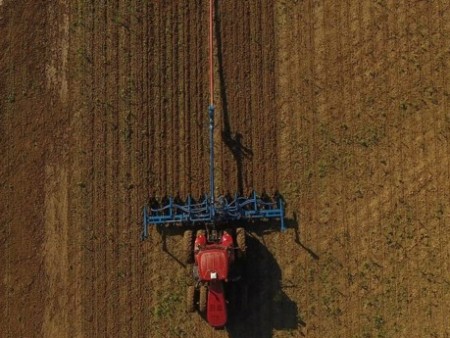In recent years, there has been increased interest in applying livestock manure on newly planted corn and soybean fields to foster their growth.
July 3, 2017

With corn needing nitrogen, and pigs and cattle producing a lot of it, anything that offers a better way to use their waste to fortify crops should intrigue farmers.
Two agriculture experts at The Ohio State University have redesigned a metal tractor attachment so that it allows farmers to put manure on a field while crops are emerging.
Applying manure to growing crops, which is not widely done nationwide, can boost yields, reduce nutrient losses and give livestock producers and commercial manure applicators another window of time to unload their waste and enrich their crops.
Made by Bambauer Equipment in New Knoxville, Ohio, the metal toolbar, which is attached to a tractor, receives waste pumped through a hose from a livestock facility manure pit. The manure is fed through the toolbar, which injects the manure 3-5 in. into the soil between the rows of growing corn, then covers the manure with soil.
The manure sidedress toolbar attachment was built with contributions from the Columbus Foundation, the Ohio Farm Bureau Federation and Goodfield, Ill.-based DSI Inc., a manufacturer of manure and nitrogen injection systems.
While draglining manure — a process that involves applying manure through a hose that pumps it directly from the livestock facility — is not new to many farmers, it is rarely used to apply manure on a growing crop.
During the growing season, farmers have been concerned that running machinery over a field with an emerging crop could crush the crop and compact the soil, leaving less space among the soil particles for easy flow of water, air and nutrients, said Glen Arnold, a manure management specialist with Ohio State University Extension, the outreach arm of the university’s College of Food, Agricultural & Environmental Sciences. Arnold designed the modified toolbar with Sam Custer, an Ohio State Extension educator in Darke County.
Traditionally, liquid manure from pigs and cattle is applied on the surface of fields in fall, after harvest. However, without a growing crop on the field to take in the nutrients, much of the nitrogen either runs off the field or percolates through the soil uncaptured, Arnold said.
“A growing crop will reach out and grab much of that nitrogen,” Arnold said. “It will love it.”
In recent years, there has been increased interest in applying livestock manure on newly planted corn and soybean fields to foster their growth and provide another chance for farmers with pigs or cattle to use their accumulating manure.
For the past five years, Arnold has conducted research on methods of doing that. Initially, he used a tanker filled with liquid manure that was applied to young corn fields in several western Ohio counties. However, the dragline and manure sidedress toolbar, compared to a tanker, weigh less and are faster and more efficient, Arnold pointed out. Also, the dragline and toolbar cause very few plants to be crushed.
For three years, the manure sidedress toolbar has been tested on fields in Darke County, which annually produces the second highest number of hogs in Ohio. The manure sidedressed fields produced 13 bu. more corn per acre compared to fields where synthetic fertilizers were applied, Arnold said.
The savings in using manure instead of synthetic fertilizer are about $80 an acre, he said.
“There’s always a cost to the livestock farmer to apply manure to farm fields. By capturing more of the nitrogen in the manure, the farmer can reduce the need to purchase commercial fertilizer and make a bigger profit,” he said.
While the manure sidedress toolbar can also be used on fields of soybeans and wheat, corn needs the most nitrogen, Arnold said.
Some Ohio farmers are concerned that the dragline could kill some of the newly emerging plants, by crushing them as it is pulled through the field, Custer said. The Darke County field research does not show that, he added. When corn is about 3 in. high, running a dragline hose across a field is not going to hurt the corn, although it may initially appear to be bent over after the dragline goes across the field, Custer said.
“In a week’s time, they’ll be standing right back up,” he said.
You May Also Like


.png?width=300&auto=webp&quality=80&disable=upscale)
